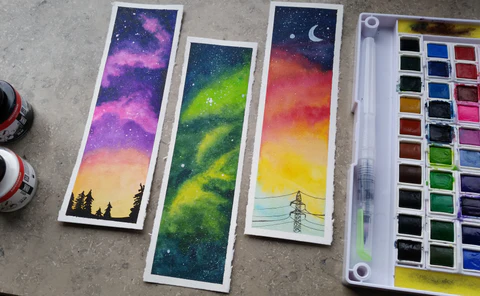Watercolor painting is a timeless art form that has captivated artists for centuries, and its popularity endures due to the vast creative potential it offers. The medium’s allure lies in its versatility and the unique effects that can be achieved, often incorporating everyday items like salt to create textures and patterns.
The Essence of Watercolor Techniques
At the heart of watercolor painting are foundational techniques such as the flat wash, wet on dry, and wet on wet. Each technique brings its own character to a piece, allowing for a range of expressions.
Flat Wash: The Purest Form
The flat wash is the simplest yet most powerful technique. It involves mixing watercolor paint with water and applying it uniformly across the paper, resulting in a consistent, unvarying hue. This technique is about purity and precision—the color you pick is the color that graces the canvas, unaltered and bold.
Wet on Dry: Layering Life
The wet on dry method introduces depth through layering. By applying a fresh coat of watercolor over a dry base layer, artists can create a visual dialogue between the two layers. This technique highlights the individual strokes and the artist’s hand, adding a dynamic element to the painting. The transparency of the new layer allows the first to shine through, creating a delicate interplay of colors.
Wet on Wet: Merging Worlds
Wet on wet is a dance of spontaneity and control. While the first layer is still damp, introducing another layer of wet paint allows the colors to blend and flow into one another. This technique is ideal for crafting organic textures and elements like foliage, water, and skies, where the colors merge naturally, mimicking the fluidity of the natural world.
Navigating Light and Dark
A fundamental rule in watercolor painting is to work from dark to light. This approach facilitates easier blending and layering, as lighter colors can be subtly introduced into darker ones. The graded wash technique embodies this principle, starting with a pigment-rich stroke that gradually becomes lighter with each pass. This creates a seamless gradient, perfect for capturing the ethereal beauty of sunsets or the vastness of the sky.
Innovative Techniques: Blossoms and Backwashing
Watercolor blossoms, a technique popularized by Impressionist Claude Monet, involves adding paint to a damp surface, allowing the new layer to gently diffuse into the existing one. This method can create dreamy, soft transitions that give a painting its impressionistic quality.
Backwashing, on the other hand, reverses the norm by introducing water to a wet layer of paint. This creates a washed-out effect, where the colors recede, giving rise to a translucent and delicate appearance.
Correcting Mistakes: The Forgiving Nature of Watercolors
One of the joys of watercolor painting is its forgiving nature. Mistakes can be rectified with ease, either by lifting the paint with a damp brush or erasing it once dry. The damp brush acts as a sponge, delicately removing the unwanted color, while an eraser can cleanly remove dry paint without a trace.
Elevating Your Art
These techniques are more than just methods; they are a gateway to elevating your artistry. By adding texture, creating smooth color transitions, and experimenting with edges, you can achieve the same mastery as the renowned watercolorists of the past. With imagination as your guide, the possibilities are limitless. Embrace experimentation and discover the myriad of techniques that await in the world of watercolors.
Watercolor painting remains a beloved medium due to its flexibility and the unique, evocative works it can produce. From the simplicity of a flat wash to the complexity of a graded wash, each technique offers a different avenue for artistic expression. Whether you’re a seasoned artist or a beginner, watercolors invite you to explore, experiment, and express your creative vision. So, pick up your brush and let the colors flow—your next masterpiece is just a stroke away.




